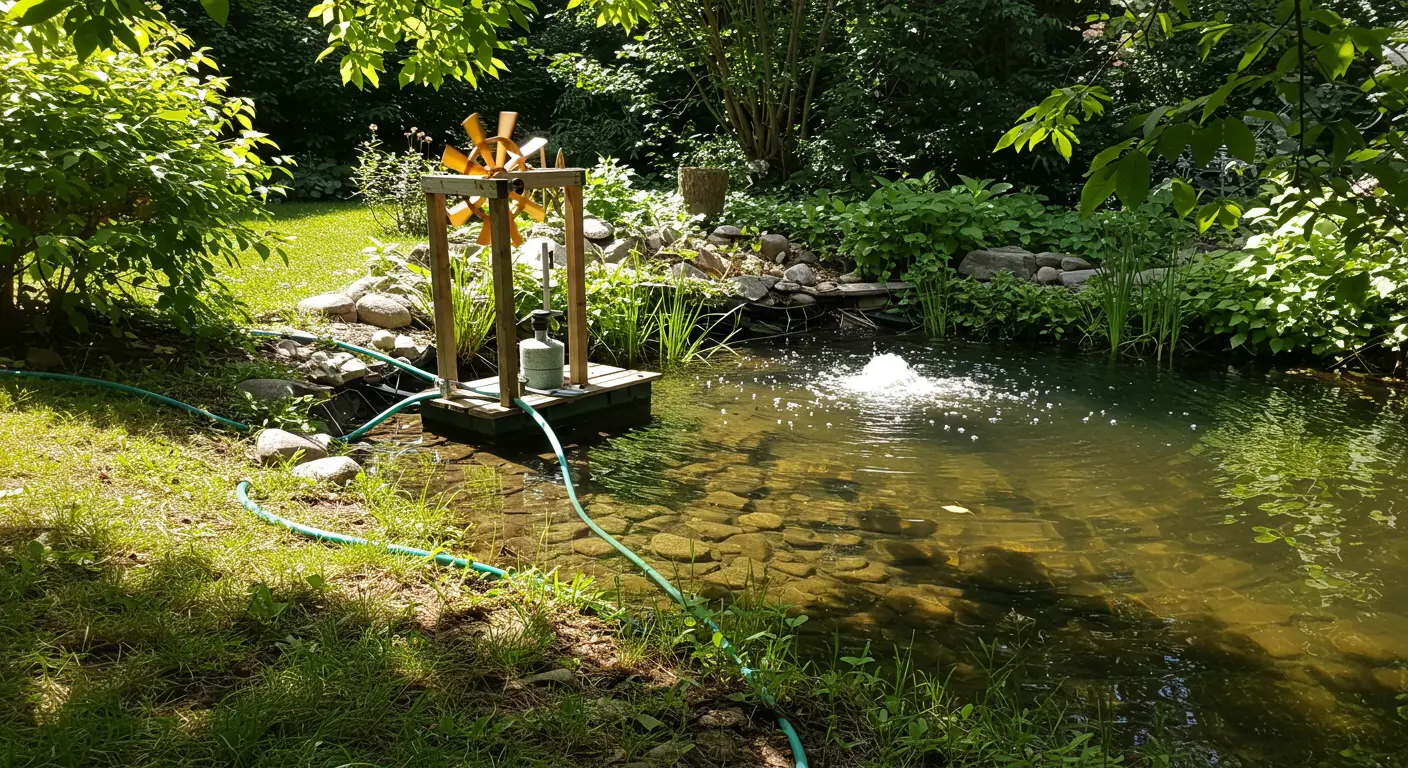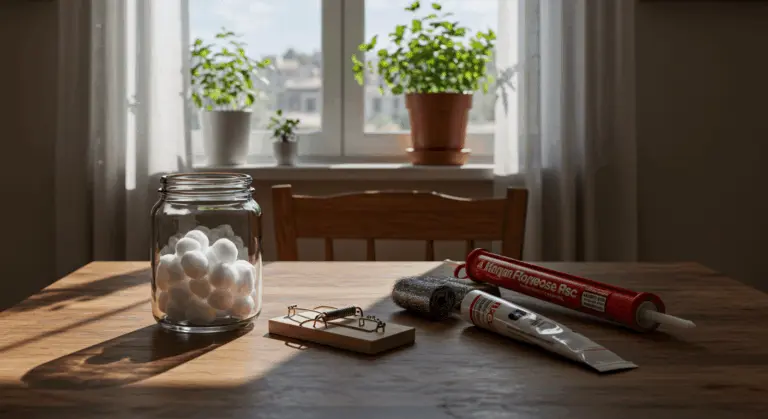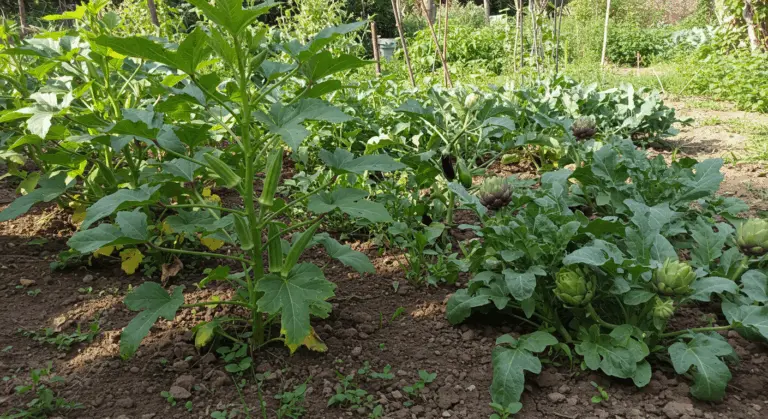Understanding Pond Aeration – Why It’s Essential
Pond aeration goes beyond simple luxury—it serves as the foundation of a thriving aquatic ecosystem. This vital process increases oxygen levels throughout the water column, creating a balanced environment where beneficial organisms flourish while naturally suppressing harmful elements.
Without adequate aeration, ponds develop distinct layers, causing oxygen-deprived water to settle at the bottom. These oxygen-starved depths become breeding grounds for bacteria that generate hydrogen sulfide—the culprit behind that unmistakable rotten egg odor—while muck steadily accumulates. In contrast, a properly aerated pond circulates water, bringing oxygen-poor water to the surface to absorb atmospheric oxygen while sending oxygen-rich water to the bottom.
This circulation creates multiple benefits for your pond ecosystem. Most importantly, it delivers life-sustaining oxygen to fish and aquatic creatures, preventing serious fish kills during hot summer months or beneath winter ice when oxygen naturally plummets. Equally important, it nurtures aerobic bacteria—nature’s cleanup crew—that efficiently decompose organic matter like fallen leaves, fish waste, and dead algae that would otherwise settle as suffocating muck.
These core advantages represent just the beginning. Proper aeration also delivers:
-
Improves water clarity by reducing suspended particles.
-
Decreases algae growth by limiting available nutrients.
-
Eliminates foul odors by preventing anaerobic decomposition.
-
Creates an attractive water feature that draws beneficial wildlife.
Simply put, aeration breathes life into stagnant water. It creates a dynamic, self-regulating ecosystem that demands less upkeep while delivering greater satisfaction.
Maintenance Considerations for Non-Electric Aerators
Though electricity-free aeration systems typically demand less maintenance than their powered counterparts, they still require regular attention to perform at their peak. Solar panels need monthly cleaning to eliminate dust and debris that can reduce efficiency by up to 25%. Position them strategically to capture maximum sunlight as seasonal angles shift throughout the year.
Biological approaches demand seasonal stewardship—thinning vigorous plant growth during peak seasons and clearing excess organic debris before winter’s arrival prevents oxygen-robbing decomposition. DIY mechanical devices should be inspected regularly for wear, damage, or clogging that might impair their effectiveness.
Using multiple approaches ensures continued oxygenation even when individual systems are compromised by weather conditions or maintenance needs. Combining solar-powered surface agitation, thoughtful plant placement, and ingenious DIY solutions creates a powerful electricity-free system that sustains optimal conditions through every season.
Solar-Powered Pond Aerators – Harnessing the Sun
Solar-powered aerators offer an effective combination of efficiency, environmental responsibility, and energy independence. These systems use sunlight to drive air pumps or fountains, delivering dependable oxygenation without inflating utility bills or demanding nearby electrical outlets.
Modern solar aeration systems come in two primary configurations: direct drive and battery backup. Direct drive units function exclusively during daylight—perfect for ponds requiring daytime oxygen supplementation. These units can typically run up to 12 hours daily, depending on sunlight availability, and can effectively service ponds up to half an acre in size and six feet in depth. Remarkably, premium solar aerators sustain impressive performance even under overcast skies, albeit at diminished capacity.
Need continuous aeration? Battery backup systems deliver the ultimate solution. These more advanced units store excess solar energy during daylight hours, enabling continuous operation through the night. With proper sizing, these systems can provide 24-hour aeration coverage without any external power source, making them particularly valuable for remote ponds or properties experiencing frequent power outages.
Solar aerators typically feature either surface fountains or submerged diffusers. Surface fountains create attractive spray patterns while boosting oxygen exchange—combining visual appeal with practical function. Submerged diffuser systems, meanwhile, release air bubbles at the pond bottom, creating vertical water circulation that distributes oxygen more evenly throughout deeper ponds.
Choosing the right solar aerator demands careful consideration of your pond’s specific characteristics: size, depth, aquatic inhabitants, and regional climate patterns. Larger ponds may require multiple solar units strategically placed to ensure comprehensive coverage. For optimal performance, position solar panels where they’ll receive maximum sunlight exposure, typically facing south in the Northern Hemisphere, and at an angle roughly equal to your latitude for ideal year-round operation.
Wind-Powered Pond Aeration – Utilizing Natural Forces
Wind power provides another effective electricity-free option for pond aeration, proving especially valuable in remote locations where solar installation proves challenging or areas with consistent breezes. Windmill aeration systems capture wind energy and transform it into mechanical force that drives air pumps, generating continuous streams of oxygen-rich bubbles throughout your aquatic ecosystem.
Traditional windmill aerators feature an above-ground windmill structure connected to a diaphragm compressor. When wind speeds reach 3-5 mph, the windmill blades begin turning, activating the compressor which pushes air through tubing to diffusers positioned at the pond bottom. These systems can effectively aerate ponds up to one acre in size and depths of 15 feet or fewer, making them ideal for medium-sized farm ponds and rural water features.
Wind-powered systems have a key advantage: they operate tirelessly around the clock, when there’s adequate breeze. Unlike solar systems that require direct sunlight, windmill aerators can function during cloudy weather and overnight hours, offering continuous aeration during critical periods when oxygen levels typically drop. Today’s windmill aerators work impressively even in gentle air currents, though they perform best in stronger winds.
Proper placement is critical. Position your windmill several hundred feet from the pond’s edge in an expansive area where wind flows freely. Avoid placing these systems near tall trees, buildings, or other structures that might create wind shadows. Most commercial windmill aerators stand between 10–20 feet tall, with taller models generally capturing more consistent wind energy.
Wind power isn’t without its challenges. Their inconsistent nature means oxygen production fluctuates with changing wind conditions, potentially creating periods of reduced aeration during calm weather. Smart pond owners therefore integrate windmill aerators into broader aeration strategies rather than relying on them exclusively. Combining wind power with other methods like solar aeration or strategic pond design can create a more reliable system that maintains healthy oxygen levels year-round.
Today’s windmill aerators now come in attractive designs. Manufacturers now craft decorative designs that function as stunning landscape centerpieces while delivering vital aeration benefits. These ornamental windmills blend functionality with visual appeal, adding a charming rustic element to your property while supporting your pond’s ecosystem health.
Natural Aeration Techniques – Enhancing Your Pond’s Health
While mechanical solutions like solar and wind-powered aerators deliver impressive results, natural aeration techniques provide an excellent complementary or alternative approach to maintaining healthy oxygen levels. These biological methods work with natural processes, creating self-sustaining ecosystems that largely manage themselves once properly established.
Aquatic plants act as natural air pumps, managing the oxygen cycle within your pond ecosystem. Submerged oxygenating plants like Hornwort, Anchors, and Water Milfoil release oxygen directly into the water during photosynthesis, creating oxygen-rich zones throughout your pond. During daylight hours, these plants work most actively, producing steady streams of oxygen bubbles that dance upward through the water column.
Floating plants like Water Lilies and Lotus work double duty—their broad leaves cast cooling shade that tames both water temperature and algae growth, while their hidden roots quietly release oxygen into the depths. The shade they create is particularly valuable during hot summer months when warm water holds less dissolved oxygen. By maintaining cooler water temperatures, these plants help prevent oxygen depletion that can stress or kill fish.
Marginal plants growing along your pond’s edges, including Cattails, Iris, and Rush species, contribute to aeration through their extensive root systems. These roots create microenvironments where beneficial bacteria thrive, helping break down organic matter and preventing the accumulation of oxygen-depleting debris. Better yet, their presence dramatically expands the interface where vital gas exchange occurs between water and atmosphere.
Thoughtfully designed waterfalls or meandering streams can be very effective for oxygen levels through natural water movement. Even a small elevation change of just 12–18 inches creates enough water agitation to significantly increase dissolved oxygen. As water tumbles over rocks and natural obstacles, it shatters the surface tension, creating countless opportunities for atmospheric oxygen to dissolve into the water. These features don’t require electricity when properly designed with gravity-fed water flow from higher elevations.
While natural aeration may not match the power of mechanical systems, it offers several distinct advantages:
-
Eco-Friendly: These methods are completely sustainable and work in harmony with nature.
-
Low Maintenance: Once established, they require minimal upkeep.
-
Increased Biodiversity: They provide habitats for beneficial insects, amphibians, and other wildlife.
-
Aesthetic Value: Lush plant life and water features enhance a property’s visual appeal.
The secret lies in orchestrating multiple natural techniques together. A thoughtfully designed pond with proper depth variations (including deeper sections of at least 2-3 feet), strategic plant placement, and perhaps a small gravity-fed waterfall can create a largely self-sustaining ecosystem. This holistic approach proves especially effective for intimate ornamental ponds, where ecological balance remains more achievable than in expansive water bodies.
Patience pays dividends here—natural aeration systems mature gradually as plants establish their roots and find their rhythm. During this establishment phase, you might need to supplement with temporary mechanical aeration, especially during hot weather or if your pond contains fish. Once fully developed, however, a well-designed natural system can maintain healthy oxygen levels with minimal intervention, creating a beautiful, low-maintenance water feature that supports diverse aquatic life.
Manual Aeration Solutions – Quick Fixes for Your Pond
When your pond demands immediate oxygen intervention, or you’re seeking straightforward, electricity-free solutions for compact water features, manual aeration techniques are your best option. These hands-on approaches provide practical pathways to boost oxygen levels without complex equipment or permanent installations.
The humble garden hose becomes an effective aeration tool. By directing a spray of water across the pond’s surface, you create agitation that facilitates gas exchange between the water and atmosphere. For best results, aim the spray to create maximum surface disturbance and continue for 15–30 minutes, ideally during early morning hours when oxygen levels are typically at their lowest. This method works well during crisis moments—when fish gasp desperately at the surface or scorching weather threatens oxygen levels.
A hand-powered water pump offers another effective manual solution, especially for smaller ponds under 500 gallons. While these pumps demand some elbow grease, they generate impressive water movement when circumstances call for action. By pumping water from the bottom of the pond and spraying it back across the surface, you not only add oxygen but also help circulate stagnant water. Some gardeners keep these pumps on hand specifically for power outages when their regular aeration systems are inoperable.
Battery-operated air pumps with diffuser stones offer a more enduring manual approach. These compact systems can run for several days on a set of batteries, making them perfect for temporary aeration during travel or system maintenance. While not truly electricity-free (as they use battery power), they don’t require grid connection and can be positioned anywhere around your pond. Those diffuser stones create bubbles, creating thousands of tiny bubbles that maximize the water-to-air contact surface for optimal oxygen transfer.
Sometimes the simplest solutions prove most effective—mechanical agitation with a paddle or rake is the most basic form of manual aeration. Simply stirring the water vigorously for 5–10 minutes creates surface disruption that allows oxygen to enter the water. While labor-intensive, this method requires no equipment beyond common garden tools and can be surprisingly effective in emergency situations. Some pond owners keep a dedicated pond paddle near their water feature specifically for this purpose.
Don’t overlook water changes as a form of manual aeration. Removing and replacing 15-25% of pond water introduces fresh, oxygen-rich water while diluting potential pollutants. When performing water changes, allow replacement water to splash into the pond from some height to maximize aeration benefits. This technique combines water quality management with oxygenation for dual benefits.
Keep in mind that manual aeration works best for emergencies rather than daily maintenance for pond health. They’re most appropriate for emergency situations, very small water features, or as supplementary techniques during particularly challenging conditions. For sustained aeration benefits, consider implementing some of the solar, wind, or natural aeration methods discussed in previous sections alongside these manual techniques for a comprehensive approach to pond health.
Choosing the Right Aeration System for Your Pond
Selecting the optimal aeration system requires careful analysis of your pond’s unique characteristics, environmental conditions, and personal objectives. No two ponds are identical, and your choice should reflect this individuality.
-
Pond Size and Depth: Small, shallow ponds may only need a solar fountain, while larger or deeper ponds (>6 feet) benefit from more robust bottom diffuser systems.
-
Location and Climate: Sunny regions are ideal for solar aerators, whereas windy locations favor windmill systems. A hybrid approach ensures consistency in variable climates.
-
Primary Purpose: Ponds with fish (especially high-oxygen species like KOI) or recurring algae problems require more powerful and consistent aeration than simple decorative water features.
-
Budget: While the initial cost of solar or wind systems can be higher, they offer long-term savings on electricity. Evaluate both upfront and maintenance costs.
-
Seasonal Needs: Aeration requirements often increase in summer as water warms and oxygen levels drop. Plan for supplementary or backup options.
-
Aesthetics: Choose a system that complements your landscape, whether it’s a decorative fountain or a discreet submerged diffuser.
Feeling overwhelmed by options? Professional consultation can be very helpful. Many pond supply companies offer free Pond Profile services where experts analyze your specific situation and provide customized aeration system layouts and pond management suggestions. These consultations typically consider factors like pond dimensions, fish population, surrounding landscape, local climate, and your maintenance preferences to recommend the most appropriate solution.
Frequently Asked Questions About Pond Aeration
As pond owners explore electricity-free aeration options, several common questions arise about implementation, maintenance, and effectiveness. Here are answers to the most frequently asked questions to help you successfully manage your pond’s oxygen levels without conventional power sources.
Maintaining consistent oxygen levels requires redundancy rather than relying on any single method. Combining solar-powered aerators with wind-driven options provides backup when one system isn’t operating optimally. Additionally, incorporating submerged aquatic plants creates a natural supplementary oxygen source that works continuously during daylight hours.
When your non-electric system fails, start with the basics: inspect for physical blockages in air lines, diffusers, or moving components. Solar systems may need panel cleaning to remove dust or debris that reduces efficiency. For wind-powered systems, ensure the windmill can rotate freely, and that connections remain secure. Having a manual backup method, such as a battery-operated air pump or fountain, provides temporary aeration during troubleshooting.
Regular maintenance is crucial for optimal performance. A typical schedule includes:
-
Monthly: Clean solar panels to remove dust and ensure they are properly angled.
-
Quarterly: Check moving parts on wind systems for wear and lubricate as needed.
-
Every 2–3 Months: Clean diffusers and air stones to prevent mineral buildup.
-
Seasonally: Perform thorough inspections before periods of extreme heat or freezing.
Many people believe electricity-free options suit only smaller ponds, but properly scaled systems can handle large ponds. Multiple windmills or solar arrays can be installed to increase capacity, and strategic placement of diffusers can maximize circulation even in ponds exceeding one acre. The key is proper system sizing and potentially combining multiple aeration methods.
Fish possess surprising resilience during brief aeration interruptions, especially in cooler weather when water naturally holds more dissolved oxygen. However, during hot summer months, oxygen depletion can occur rapidly. Having emergency backup options like battery-operated air pumps or knowing how to quickly implement manual aeration techniques can prevent fish loss during system failures.
Is aeration necessary for small decorative ponds? Even small water features benefit from proper aeration. Without it, stagnant conditions can quickly lead to algae blooms, foul odors, and poor water clarity. For very small ponds, simple solar floating fountains or manually added beneficial bacteria can maintain adequate oxygen levels without complex systems.
You can tell if your pond has adequate oxygen through several telltale signs:
-
Fish are active and not gasping at the surface.
-
Water is clear, not murky or green.
-
Algae growth is minimal.
-
There are no foul odors.
For a more precise measurement, use an inexpensive dissolved oxygen test kit.
Solar-powered surface aerators usually provide the best balance of affordability, effectiveness, and minimal maintenance for most small to medium ponds. For extremely tight budgets, strategic placement of oxygenating aquatic plants combined with occasional manual aeration can provide basic oxygen support with minimal expense.




